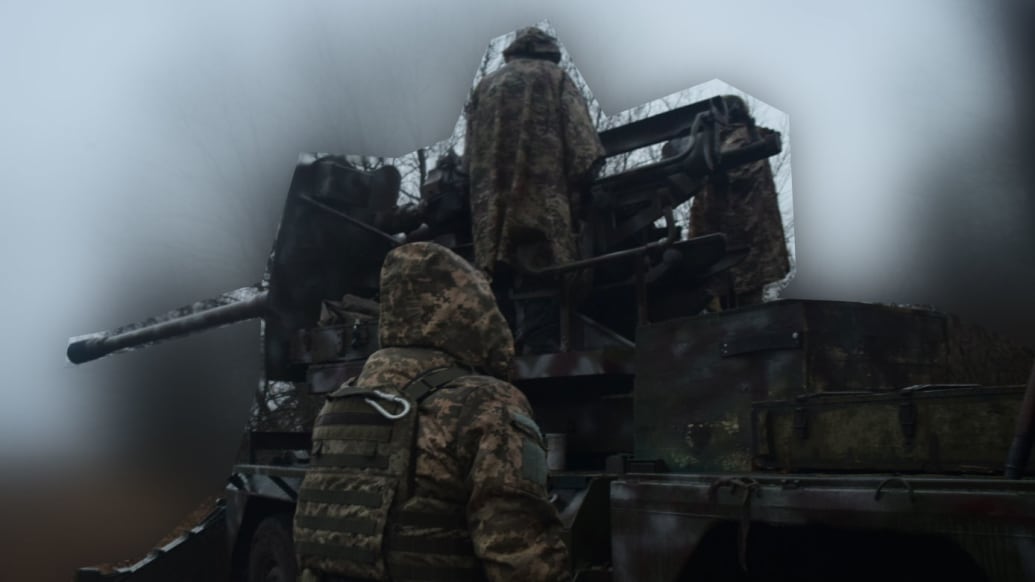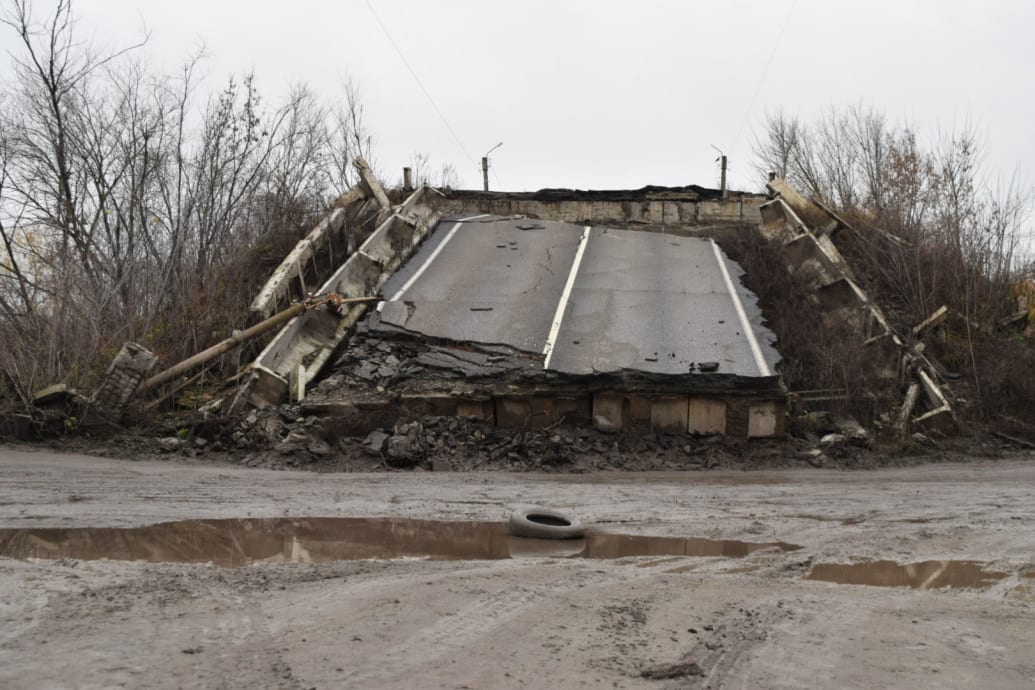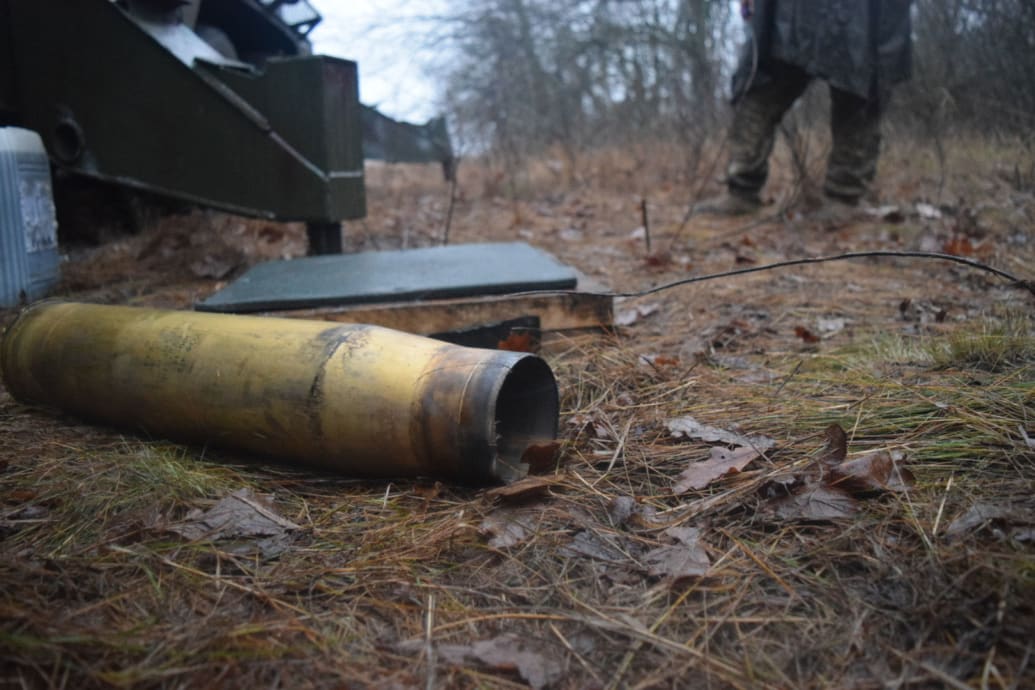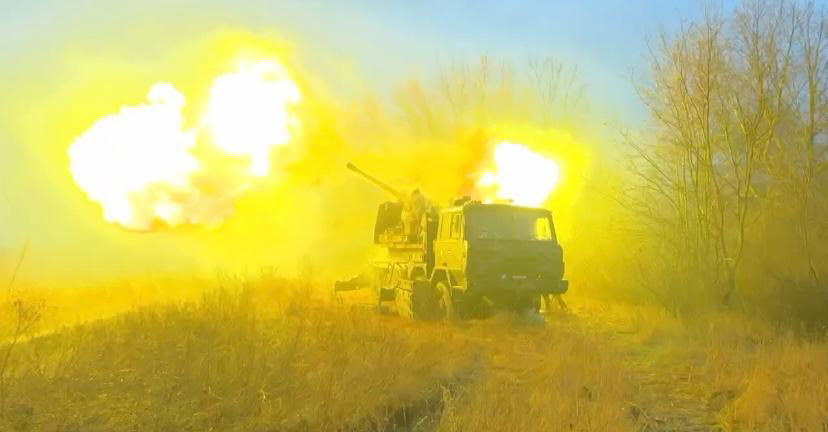KUPIANSK, Ukraine—In an old garage outside of Kupiansk, a unit of soldiers is turning to the past in their search for weapons to fight off Russian soldiers, as the fate of the eastern city remains in the balance. One inventive unit is modernizing old Soviet-era KS 19 anti-aircraft guns and turning the antiquated machines into fast-moving weapons of destruction that can be used to target dozens of Russian soldiers at a time. With an ingenious act of improvisation and some commercially-available tech, they are turning the Kremlin’s history against the Russian army.
The Soviet Union was once a major arms exporter, spreading its supply of tanks, artillery, air defense systems, and armored personnel carriers throughout the world, but particularly Eastern Europe, including Ukraine. For decades, Ukraine had a supply of weapons left over from the days of their communist shackles that were used both in Russia’s 2014 invasion of the Donbas region and at the beginning of the full-scale war that began on Feb. 24, 2022. As Russia launched attacks from all sides, soldiers and civilian fighters took up arms in any way they could, including with the weapons made by their invading force.
Over time, the Kremlin’s relics were replaced as new Western weapons like Leopard Tanks, American M777s, and High Mobility Artillery Rocket Systems were introduced to the frontlines. Ukraine has received $100 billion in military aid over the last 21 months of war and has managed to ward off masses of Russian forces stationed throughout their homeland. In areas like Lviv and Kyiv, life has returned to relatively normal as the two-year mark of the war rapidly approaches.
While Western support has remained steadfast throughout the war, on Nov. 16, U.S. President Joe Biden signed a temporary spending bill into law to halt a government shutdown, and no new aid to Ukraine was listed in the bill. Further assistance to the war-torn country is at a standstill, and the soonest Congress could complete negotiations and deliver new aid to Ukraine is expected to be in mid-December, but it might be pushed back even longer, causing fears that aid from one of Ukraine’s largest supporters might be diminishing.
The uncertainty of what role Western aid would play for Ukraine in the future and a decrease in weapon supply led Sergeant Evegeny Iitvin and the Artillery Battery Unit in the 241st brigade of Ukraine’s military to rely on Soviet-era weapons again. Last March, they were given four KS-19 anti-aircraft guns, weapons that were made shortly after the end of the Second World War and have been used in various wars, including the Korean War and America’s wars in Vietnam and Afghanistan.
Anna Conkling/The Daily Beast
The guns were made to be used against air targets with a speed of up to 745 miles an hour and a flight altitude of nine miles and weighing up to ten tons. Earlier in the war, Ukrainians began to experiment with using these anti-aircraft guns in ground combat against Russian soldiers with devastating effects.
In Kupiansk, the Artillery Battery has gone a step further and mounted the weapons onto the back of civilian trucks which allows them to be driven at speed into and then out of the combat zone.
Alongside donors including the Ukrainian Okwine alcohol company, friends, and colleagues, the unit is funding restoration projects for the guns they have been given, which includes dissembling the weapons, loading its pieces onto the bed of a freight truck, and rebuilding them on the platform. The end result, which is a three-month long process, is a mobile weapon of destruction that can shoot at targets up to 328 feet radius, and once it explodes, releases 1,000 small pieces of shrapnel into the vicinity, making it a deadly force that can harm and kill dozens of Russian soldiers at a time.
In the garage where his team is remodeling the weapons, Iitvin told The Daily Beast, “If Biden provided weapons, I would not need these guns.” The lack of a constant stream of Western supplies led the sergeant to look for other forms of weapons, which in March resulted in him being given four KS-19s by Ukraine’s military.

Anna Conkling/The Daily Beast
Iitvin began to think of ways to make using the weapons more modern and easier to use, which included equipping the machines with $8,000-worth of iPad-like off-the-shelf tablets that he and his men bought from civilian stores with their own money. Paired with a drone and operator, the tablet can be used to track Russian military movement and navigate attacks. Speaking of the improvised tracking system, Iitvin said, “It’s very simple. It’s like a box with two antennas; you just put it on the gun, you put two antennas on the barrel, one on the edge of the barrel and the other on another side. And it gives it all by itself.”
The remodeling of the guns also included trips to nearby European countries, like the Czech Republic, where, along with donors, friends, and his men, Iitvin bought four Tatara freight trucks that would be used to transport the guns with ease on the frontlines. The trucks alone have cost $80,000 per vehicle, he said. They spray painted the vehicles in camo colors themselves.
“First came the old guns, which are not maneuverable and which no one wants to work with them much. I called a friend and said let’s raise the money and do it (buy trucks),” said Iitvin.
“I’ve already fought on the frontline. I already had the guns. I already understood their effectiveness, their safety, and that everything can be better and more convenient. I came up with the idea that I should put the gun on the car. We brought, renovated, and installed it,” he added.
While Soviet-era weapons have been used by units throughout Ukraine, Iitvin believes that he is the first to think of placing the heavy KS 19 guns on trucks and bringing them to the front. The work, for the most part, has been without the finances of the military, which at the moment cannot afford the additional costs of supplying tens of thousands of dollars to specific units for their military projects, the sergeant said.
Throughout Ukraine’s frontlines, soldiers are experiencing a lack of critically needed supplies. While Kyiv has set a 2024 budget for the military at $42 billion, spending comes at a time when much of the country is fighting to ward off Russian forces, one of which is Kupiansk. The city—73 miles from Kharkiv—was one of the first cities to surrender without condition to Russian troops after the invading country began its full-scale invasion of Ukraine last year. For more than six months, it would remain under Russian occupation until Ukraine liberated the city in September 2022, part of a rapid counteroffensive that saw Kyiv reclaim masses of land at a pivotal point in the war.
But the city that is located on two sides of a river is now at a standstill. In Kupiansk, The Daily Beast saw that Russian soldiers had destroyed the bridge that once connected the two sides, and advanced on the city. Police have been evacuating civilians in the east side of the city for days, bringing them to the west, which, for the time being, is seemingly safer, despite constant attacks on the city and the omnipresent deafening sounds of explosions.

Anna Conkling/The Daily Beast
Near the Artillery Battery’s frontline position six miles from the nearest enemy units, a soldier named Iusii told The Daily Beast that the situation in Kupiansk is “kind of tense, but we are holding them back, we don’t let them pass. When they storm and assault, we are given targets right away. We immediately hit the human force.”
Iusii lights a cigarette as he speaks, while behind him, Iitvin tends to his car, which had just overheated on its way to show The Daily Beast one of the guns in action. Like many of Ukraine’s brigades, Iitvin was gifted his car by volunteers who work to provide the military with vehicles, which are often damaged and destroyed so frequently that supplies too are rapidly decreasing.
Before overheating, the car had driven down a narrow dirt road with large gaps in the asphalt, which had been damaged by constant wear of both military vehicles and civilian use. But driving through rain and long bouts of mud as the winter rapidly approached caused the vehicle to give in and accept defeat temporarily.
After 20 minutes of turning the engine on and off again, and pouring water into the engine’s radiator to cool it off. The car finally roared back to life and made its way to its location, where five soldiers in disposable raincoats stood guard around the old Soviet weapon with machine guns in hand.
This gun had just been in use for three days, but between various locations, Iitvin said it had “Already destroyed 1,000 (Russian soldiers). The idea is to hit from the first shot. But we need three times to shoot it. A 50-meter miss counts as a shot for these projectiles. It has a radius of the less than of 100 meters.”
“Today it is especially beautiful,” he added, referencing the clear skies that had encompassed Ukraine before the sun began to set at 3 p.m. The gun takes six minutes to load and shoot, and once it is fired, the blast pushes those standing nearby back a few inches, and the sudden boom of the cannon rings through the cold autumn air as nightfall reaches Ukraine. After the gun has been fired, Iitvin grabs the empty shell remnants and puts it in the trunk of his car to bring back to the workshop with him.

Anna Conkling/The Daily Beast
At the garage, Iitvin said that he is aware that Russians, too, are using Soviet relics in their fight to gain control of Ukraine. The difference between the two fighting sides, the sergeant said, is that Russia’s military has not progressed past the USSR, where each military move had to go through a chain of bureaucratic permission and approval, while Ukraine’s military acts based on the situations as they arise without waiting for the situation to play out. They hope their ingenuity can save them.
“We are now a generation that is releasing us from Russian influence,” said Iitvin. “This is very important for our future, for the future of our children, because Russians are a backward race. They die for Putin. Putin is a tsar. And we’re free people. We’re fighting for freedom. To be free from them. This is my philosophy,” he added.








